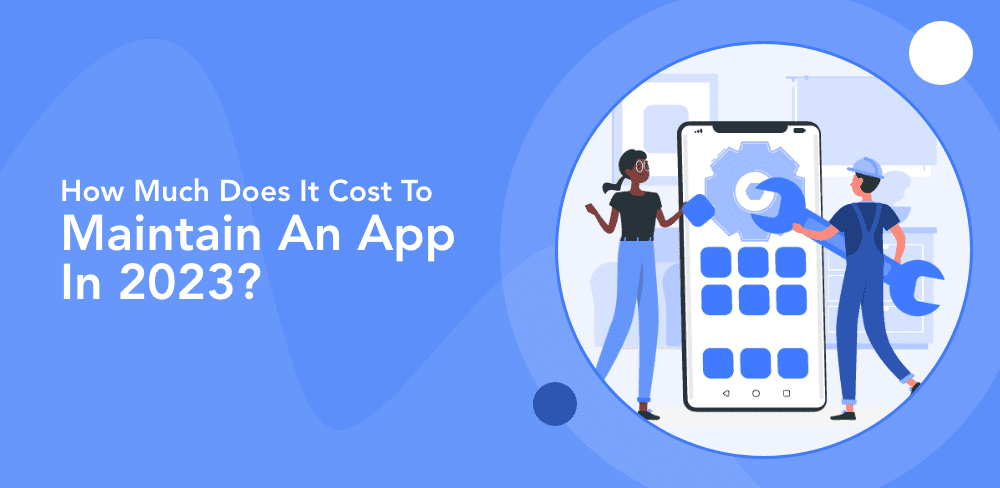The cost to maintain an app is an issue that will never go out of date in the ever-changing technology landscape. It’s important to know the financial commitments required to keep your app secure, competitive, and user-friendly as we move into 2023. The cost to maintain an app can be varied, from bug fixes and routine updates to adapting to industry trends.
This blog will explore the details of app maintenance expenses, including platform updates, security upgrades, feature enhancements, and user support. Hire mobile app developers with a better understanding of the financial factors involved in maintaining a successful mobile app. We will help you to make better decisions about the future of your app by demystifying expenses.
4 Types of Mobile App Maintenance
Mobile app maintenance is an important aspect of app development that’s often overlooked. Many organizations spend significant resources on designing, developing, and launching mobile apps. However, they often neglect the maintenance needed to maintain the app’s performance, security, and functionality. Mobile app maintenance can be divided into four types:
1. Corrective Maintenance
The most common form of app maintenance is corrective maintenance. It also goes by the name bug fixing. It involves identifying and reporting bugs or issues that users experience while using an app. The issues may range from minor bugs to serious errors that impact the app’s function. To maintain an app that runs smoothly and provides a positive experience for users, it is important to perform corrective maintenance. Updates and bug fixes will be required to fix issues that may arise due to changes in hardware, operating system, or dependencies on third-party software.
2. Adaptive Maintenance
Adaptive maintenance focuses on adapting mobile apps to changes in their operating environment. It is important to ensure that the app is compatible with new operating systems, devices, and hardware specifications. It may include adjusting the user interface of an app to accommodate changes in screen resolutions or sizes. Apps need to keep up with the latest technology to offer users a seamless experience.
3. Perfective Maintenance
The goal of perfective maintenance is to improve the existing capabilities and features of an app. It involves improving the performance, usability, and functionality of an app. This type of maintenance does not only fix problems but also refines and optimizes the app in order to meet changing user expectations. The enhancements may include new features, improving code performance, and improving user interface to make it more intuitive. The app will remain competitive and appealing to users if it is maintained properly.
4. Preventive Maintenance:
Preventive maintenance is focused on proactively identifying potential issues and mitigating them before they impact the performance or security of an app. This type of maintenance is designed to reduce vulnerabilities and prevent future issues. It also ensures that the app remains reliable. This type of maintenance includes code reviews, performance monitoring, and security audits. Preventive maintenance reduces the need for future corrective maintenance by addressing any potential vulnerabilities or weaknesses in advance.
Why Is Mobile App Maintenance Crucial?
Before we learn how much it costs to maintain an app, it is crucial to know why it’s important. In the dynamic world of mobile applications, innovation is the driving factor; creating a mobile application is only the beginning of an exciting journey. Maintenance is an aspect of app creation that is often overlooked, but it is important for many reasons. This blog will explore the importance of mobile app upkeep and how neglecting this can cause significant problems for business owners and app owners.
1. Bug Fixing and Issue Resolution:
Bugs and other issues may still appear over time, no matter how carefully an app has been developed. These problems can result in a negative user experience, a decrease in retention, and a negative review. Regular monitoring and debugging are required to detect and correct these issues. You can keep your users happy and build a positive image by ensuring that your app is running smoothly.
2. Compatibility With OS Updates
Updates are released frequently by mobile operating systems such as iOS and Android. These updates include new features, improvements in security, and functional changes. If you do not keep your app updated, it may malfunction or become incompatible. By maintaining your app, you can ensure that it will continue to work seamlessly on the latest OS releases. It will expand your user base as well as retain existing customers.
3. Security Enhancements
Cybercriminals are constantly evolving their strategies and tools as technology improves. Mobile app security is an ongoing battle. Maintaining your app involves implementing security updates and patches to protect your users’ data and maintain their trust. Neglecting maintenance of security can expose vulnerabilities, which may lead to security breaches or other issues.
4. Performance Optimization
An app may become less responsive over time due to the accumulation of data or poor coding. Performance optimization is part of regular maintenance and helps to keep your app running smoothly. It is particularly important for resource-intensive apps, like games or those with complicated functionality.
5. Feature Enhancements:
What was innovative when your app first launched may have become obsolete over time. It’s important to add new features and enhance existing ones in order to remain competitive and relevant. App maintenance helps you adapt to market and user trends and ensures your app is functional and attractive.
6. User Feedback Integration
Users are often willing to provide feedback on your app. They may highlight areas for improvement or suggest new features. Maintenance includes evaluating feedback from users and integrating suggestions. It helps to foster a stronger relationship with your user base and improves overall satisfaction.
7. Updates on Legal and Compliance:
Mobile apps are subject to changes in the legal landscape. New regulations on data privacy, accessibility, and other issues will be implemented. It is important to maintain your app in order to comply with the most recent legal requirements. It will reduce the risk of fines and legal issues.
8. Server Maintenance:
Backend servers are essential for many mobile apps to work correctly. These servers need regular maintenance, including security upgrades, updates, and scaling to increase user load. Neglecting to maintain your server can result in downtime or poor performance of your app.
9. Cost-Efficiency:
It may seem counterintuitive, but maintaining an application is more cost-effective than starting from the beginning. Ignoring maintenance may lead to more serious issues that will require significant development effort. Regular maintenance can prevent major issues and reduce long-term costs.
10. Competitive Edge
The mobile app market is highly competitive and offers users a wide range of options. Well-maintained apps are more likely to perform better than outdated or unreliable options. By maintaining your app, you can ensure that your app remains competitive and is well-positioned to attract users.
11. User Retention
Well-maintained apps lead to increased user satisfaction and retention. Apps that meet their expectations and needs consistently are more likely for users to stay with them. It leads to a larger user base and possibly higher revenue through advertising or in-app purchases.
12. Brand Reputation
Your brand’s reputation is directly tied to your app’s performance and quality. Maintaining a positive image of your brand requires regular maintenance. If your app is not well maintained, users will likely associate the problems with your brand. It could damage your reputation.
Major Factors Affecting the Cost to Maintain an App in 2023?
If you are looking to know“ how much does an app cost to maintain,” then you should know the cost to maintain an app in 2023 will vary greatly depending on a variety of factors. Understanding these factors is important for budgeting app maintenance and making informed decisions. We will examine the main factors that affect the cost to maintain an app in 2023.
1. App Complexity:
One of the main factors that influence the cost to maintain an app is complexity. Apps that have simple features and simple functionality require less maintenance. Complex apps, with their many features, advanced functionality, and integrations, will require more maintenance. Complex apps have more bugs and, therefore, require more testing and updating. It leads to higher costs to maintain an app.
2. Platform and Device Compatibility
Mobile devices and operating systems are diverse. There are many different types of mobile devices, including phones, tablets, and wearables. Maintaining your app on different platforms and devices increases the cost to maintain an app. To maintain a seamless experience, each new device or operating system release may require testing and updates. It will be especially relevant in 2023 as operating systems and device technology continue to evolve.
3. App Size and Data Handling:
The cost to start and maintain an app can be affected by the size and data handling of your app. Server and storage costs may be higher for large apps that require extensive data storage or processing. Apps that require frequent updates of data or real-time interaction may also need more server maintenance in order to maintain data integrity and performance.
4. Third-Party Integrations:
For various functions such as geolocation, social media sharing, or payment processing, many apps depend on APIs from third parties. If these third-party APIs change or require updates, the cost to maintain an app may increase. To ensure compatibility, it’s important to keep up with any third-party services that your app depends on.
5. Security Concerns
App maintenance is concerned with security. Cybersecurity threats continue to evolve, so ensuring your app is secure requires a continuous process. To protect user data, regular security audits and updates are necessary to maintain the app’s reputation. Data breaches can be costly and cause damage to your brand if you fail to address any security concerns.
6. User Base and Usage
The cost to maintain an app can be affected by the number of users or level of engagement. On-demand app development that has a large, active user base will require more frequent support and updates as more users report issues and demand new features. The cost of scaling server infrastructure in order to meet user growth is also increased.
7. Regulatory Compliance
Apps will need to comply in 2023 with numerous privacy laws and regulations, including GDPR and CCPA. It is important to ensure that your app adheres to these regulations and addresses the privacy concerns of users. Regular audits, updates, and changes to the data handling practices can increase the cost of maintain an app.
8. Technology Stack:
The cost to maintain an app can be affected by the technology stack you choose to build your app. Some technologies cost more to maintain because of licensing fees, support expenses, or the lack of availability to hire android app developers. Moreover, obsolete or unsupported technology may require expensive updates to ensure compatibility and security standards with new platforms.
9. Geographical Location of the Development Team:
Hire full stack developers‘ location is another factor for development and maintenance can also affect the cost to maintain an app. The availability of developers and labor costs vary widely around the globe. Hire dedicated developers in regions where labor costs are higher can lead to increased maintenance costs.
10. Server and Hosting Costs:
Hosting and infrastructure costs will be incurred by apps that use server-side components, cloud services, or both. The cost of hosting and infrastructure can vary depending on factors such as the amount of data storage, server usage, bandwidth, etc., as well as any spikes in traffic.
11. Regular Updates and Feature Enhancements:
Updating your app regularly to add new features, enhance the user experience, and fix bugs are all important parts of maintenance. The higher your cost to maintain an app, the more often you release updates. Updates are essential for keeping users happy and engaged.
12. User Support and Feedback
It is vital for the success of an app to have a team that can respond to user feedback and inquiries. The cost to maintain an app can be affected by the size and efficiency & the hire of a mobile app designer team, especially if you have a large volume of issues or user questions to resolve.
How Much Does It Cost to Maintain an App in 2023?
If you are looking to know “how to estimate the costs of maintaining an app,” then it is crucial to dive into this section. It can be difficult to estimate the cost to maintain an app in 2023, as it is dependent on a number of factors. Here is a table that shows how the cost to maintain an app can be affected by various factors. The ranges are low, medium, and high.
| Factor | Low-Cost Estimate |
| App Complexity | $5,000 – $15,000 |
| Platform and Device Compatibility | $2,000 – $5,000 |
| App Size and Data Handling | $1,000 – $5,000 |
| Third-Party Integrations | $2,000 – $5,000 |
| Security Concerns | $5,000 – $10,000 |
| User Base and Usage | $2,000 – $10,000 |
| Regulatory Compliance | $2,000 – $5,000 |
| App Store Guidelines | $1,000 – $5,000 |
| Technology Stack | $2,000 – $5,000 |
| Geographical Location of Development | $5,000 – $10,000 |
| Server and Hosting Costs | $1,000 – $5,000 |
| Regular Updates and Feature Enhancements | $5,000 – $10,000 |
| Technical Debt | $2,000 – $5,000 |
| User Support and Feedback | $2,000 – $5,000 |
| App Performance Optimization | $2,000 – $5,000 |
These estimates are only approximate ranges of cost to maintain an app. The cost to maintain an app will vary depending on the cost to hire android app developers for specific applications and circumstances. To get a more accurate estimate of the costs to maintain an app, it’s important to evaluate your app’s unique characteristics and consult experts.
How to Reduce Mobile App Maintenance Cost
Reduced mobile app maintenance is essential for maximizing return on investment and ensuring long-term success. Costs to maintain an app are a part of owning an app, but there are strategies and best practices to help minimize them. Here are a few ways to lower mobile app maintenance costs:
1. Plan Maintenance From the Start:
Plan for maintenance from the time you build a mobile app. You can simplify future updates by considering maintenance requirements during the design and implementation phases. A well-designed architecture, clean code, and an organized codebase will reduce future maintenance costs.
2. Select the Right Technology Stack:
The cost to maintain an app can be significantly reduced by selecting the right technology stack. Cost-effectiveness can be achieved by using open-source technologies or frameworks that are widely supported. This is because there is a large mobile app maintenance services community that can help with problems and improvements. Consider cross-platform frameworks such as React Native and Flutter that allow you to maintain one codebase across multiple platforms. It reduces ongoing development and maintenance.
3. Regular Code Review and Refactoring:
Incorporate a culture that encourages regular code reviews and the refactoring of code within your team. Code reviews can help you identify issues before they become major problems, and refactoring is a great way to reduce technical debt while improving the maintainability of your code. You can reduce the likelihood of critical issues and streamline maintenance by maintaining an efficient and clean codebase.
4. Automated Testing and Continuous Integration:
Automated testing and continuous integration can help you catch issues and bugs during the development phase. Continuous integration tools such as Jenkins and Travis CI automate the building and testing of your app. It ensures that new code changes don’t introduce regressions or other issues. It saves time and energy spent on manual testing during maintenance.
5. User Feedback Loops:
Encourage users to provide feedback and create feedback loops in order to better understand their concerns and needs. You can avoid negative reviews by responding to user feedback and issues as soon as they are reported. An active approach to support users can prevent expensive maintenance issues.
6. Optimize App Performance:
Performance optimization can reduce maintenance costs significantly. Your app will run more efficiently if it runs well. It will consume fewer resources and cause fewer complaints from your users. Monitor and analyze the performance of your app regularly to identify bottlenecks and areas for improvement and optimize code, database queries, and other resource-intensive tasks.
7. Security Measures:
Stay up-to-date with the latest security techniques and invest in robust security measures right from the start. Regular security audits and penetration testing can prevent security breaches. It is usually cheaper to address security vulnerabilities quickly than to deal with the aftermath of data breaches.
8. Proactive Maintenance:
Regularly updating your app is part of proactive maintenance. It is important to keep up with changes in operating systems, third-party services, and app store policies. Being proactive can help you avoid costly, sudden issues and reduce the need for emergency repairs.
9. Use Analytics and Monitoring:
Use app analytics and monitoring to get insights into app performance and error rates. These tools will help you to identify areas for improvement and prioritize maintenance. They can also help predict potential problems before they become serious.
10. Effective Documentation:
Documenting your app thoroughly and keeping it up to date is important. The documentation should cover the architecture, codebases, APIs, and configurations. This documentation can streamline the onboarding of new team members and save time when performing maintenance and troubleshooting tasks.
11. Version Control:
Manage your app’s code using version control software (e.g., Git). Version control allows you to track changes, maintain different code branches, and roll back easily in the event of an issue. It is a great way to reduce maintenance and manage risk.
12. Prioritize Features with Care:
Consider the impact of new features and enhancements on your maintenance costs. Add features that will not add complexity or update frequently unless it is essential to the success of your app. Maintain a balanced approach when developing features.
13. Regular Updates:
Update your app regularly to add new features and fix any bugs. Updates can help prevent issues from building up, which could be expensive to fix all at once. You can keep your app more efficient and stable by releasing smaller updates more frequently.
Conclusion
The cost to maintain an app in 2023 will vary greatly depending on a number of factors, including the complexity of the app, compatibility with platforms, and cost to hire node js developer. To manage these costs, it’s important to plan for maintenance at the start, use efficient development methods, and be proactive when addressing issues. It’s difficult to give an exact number, but managing these factors can help you keep your cost to maintain a cross-platform app down and ensure that your app is successful in the long run.
FAQ
Q1. What Will The Average Cost Be For App Maintenance In 2023?
The cost to maintain an app in 2023 will range between $5,000 and $15,000 a month, depending on their complexity.
Q2. What Are The Factors That Influence App Maintenance Costs?
App maintenance costs can be affected by factors such as the complexity of an app, its size, updates to platforms, and new features.
Q3. Can App Maintenance Be Done At A Lower Cost?
Regular monitoring, bug fixes, and efficient code management can reduce the cost to maintain an app.
Q4. How Do I Budget For App Maintenance?
Budgeting for maintenance is essential from the beginning. Allocate 20-30% annually of the original development costs.
Q5. What Are The Consequences If You Neglect App Maintenance?
Neglecting to maintain your app can lead to performance problems, security vulnerabilities, and a decrease in user satisfaction. These can all be expensive to fix.












